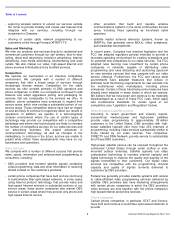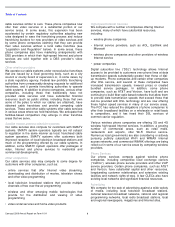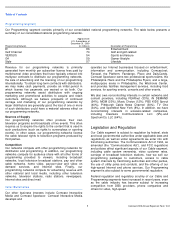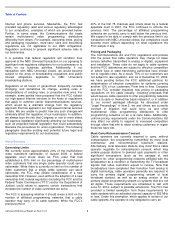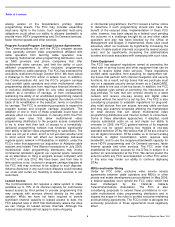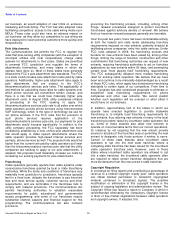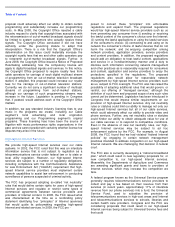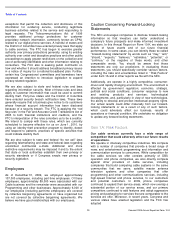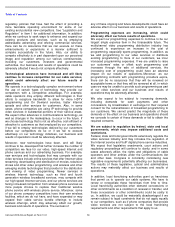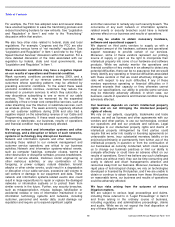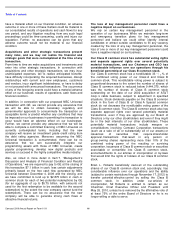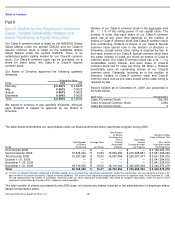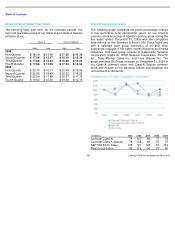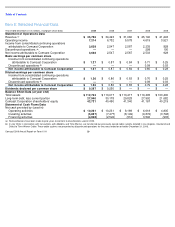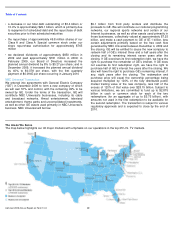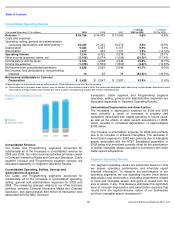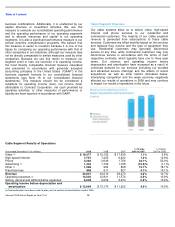Comcast 2009 Annual Report Download - page 20
Download and view the complete annual report
Please find page 20 of the 2009 Comcast annual report below. You can navigate through the pages in the report by either clicking on the pages listed below, or by using the keyword search tool below to find specific information within the annual report.
Table of Contents
Comcast 2009 Annual Report on Form 10-K
14
regulatory policies that have had the effect of providing a
more favorable operating environment for some of our
existing and potential new competitors. See “Legislation and
Regulation” in Item 1 for additional information. In addition,
while we continue to seek ways to enhance and expand our
existing products and services, such as by employing
addressable advertising and offering commercial services,
there can be no assurance that we can execute on these
enhancements or expansions in a manner sufficient to
compete successfully in the future. Also, our ability to
compete effectively is in part dependent upon our perceived
image and reputation among our various constituencies,
including our customers, investors and governmental
authorities. Our business and results of operations could be
adversely affected if we do not compete effectively.
Technological advances have increased and will likely
continue to increase competition for our cable services,
which could adversely affect our future results of
operations.
We operate in a technologically complex environment where
the use of certain types of technology may provide our
competitors with a competitive advantage. For example,
cable operators may employ different technologies in their
efforts to recapture bandwidth to allow for more HDTV
programming and On Demand services, faster Internet
speeds and other services for customers. Also, in some
cases, phone companies are using IP technology to provide
video services in substantial portions of their service areas.
We expect other advances in communications technology, as
well as changes in the marketplace, to occur in the future. If
we choose technology that is not as effective, cost
-efficient or
attractive to customers as that employed by our competitors,
if we fail to employ technologies desired by our customers
before our competitors do so or if we fail to execute
effectively on our technology initiatives, our business and
results of operations could be adversely affected.
Moreover, new technologies have been, and will likely
continue to be, developed that further increase the number of
competitors we face for our video, high-speed Internet and
phone services and our advertising business. For example,
new services and technologies that may compete with our
video services include online services that offer Internet video
streaming, downloading and distribution of movies, television
shows and other video programming, and wireless and other
emerging mobile technologies that provide for the distribution
and viewing of video programming. Newer services in
wireless Internet technology, such as third and fourth
generation wireless broadband services, may compete with
our high-speed Internet services, and our phone services are
facing increased competition from wireless phone services as
more people choose to replace their traditional wireline
phone service with wireless phone service. Moreover, some
of our phone company competitors have their own wireless
facilities, which we do not have, and have expanded or may
expand their cable service bundle offerings to include
wireless offerings, which may adversely affect our growth,
business and results of operations. The success of
any of these ongoing and future developments could have an
adverse effect on our business and results of operations.
Programming expenses are increasing, which could
adversely affect our future results of operations.
We expect our programming expenses to continue to be our
largest single expense item in the foreseeable future. The
multichannel video programming distribution industry has
continued to experience an increase in the cost of
programming, especially sports programming. In addition, as
we add programming to our video services or distribute
existing programming to more of our customers, we incur
increased programming expenses. If we are unable to raise
our customers’ rates or offset such programming cost
increases through the sale of additional services, the
increasing cost of programming could have an adverse
impact on our results of operations. Moreover, as our
programming contracts with programming providers expire,
there can be no assurance that they will be renewed on
acceptable terms or that they will be renewed at all, in which
case we may be unable to provide such programming as part
of our video services and our business and results of
operations may be adversely affected.
We also expect to be subject to increasing demands,
including demands for cash payments and other
concessions, by broadcasters in exchange for their required
consent for the retransmission of broadcast programming to
our customers. We cannot predict the magnitude of these
demands or the effect on our business and operations should
we concede to certain of these demands or fail to obtain the
required consents.
We are subject to regulation by federal, state and local
governments, which may impose additional costs and
restrictions.
Federal, state and local governments extensively regulate the
video services industry and may increase the regulation of
the Internet service and VoIP digital phone service industries.
We expect that legislative enactments, court actions and
regulatory proceedings will continue to clarify, and in some
cases adversely affect, the rights and obligations of cable
operators and other entities under the Communications Act
and other laws. Congress is constantly considering new
legislative requirements potentially affecting our businesses.
The results of these legislative, judicial and administrative
actions may materially affect our business and results of
operations.
In addition, local franchising authorities grant us franchises
that permit us to operate our cable systems. We have to
renew or renegotiate these franchises from time to time.
Local franchising authorities often demand concessions or
other commitments as a condition of renewal or transfer, and
these concessions or other commitments could be costly to
us. In addition, we could be materially disadvantaged if we
remain subject to legal constraints that do not apply equally
to our competitors, such as if phone companies that provide
video services are not subject to the local franchising
requirements and other requirements that apply to us.


